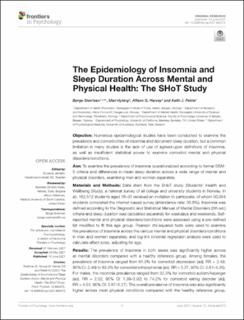| dc.description.abstract | Objective: Numerous epidemiological studies have been conducted to examine the prevalence and comorbidities of insomnia and document sleep duration, but a common limitation in many studies is the lack of use of agreed-upon definitions of insomnia, as well as insufficient statistical power to examine comorbid mental and physical disorders/conditions.
Aim: To examine the prevalence of insomnia operationalized according to formal DSM-5 criteria and differences in mean sleep duration across a wide range of mental and physical disorders, examining men and women separately.
Materials and Methods: Data stem from the SHoT study (Students’ Health and Wellbeing Study), a national survey of all college and university students in Norway. In all, 162,512 students aged 18–35 received an invitation to participate, of whom 50,054 students completed the internet-based survey (attendance rate: 30.8%). Insomnia was defined according to the Diagnostic and Statistical Manual of Mental Disorders (5th ed.) criteria and sleep duration was calculated separately for weekdays and weekends. Self-reported mental and physical disorders/conditions were assessed using a pre-defined list modified to fit this age group. Pearson chi-squared tests were used to examine the prevalence of insomnia across the various mental and physical disorders/conditions in men and women separately, and log-link binomial regression analysis were used to calculate effect-sizes, adjusting for age.
Results: The prevalence of insomnia in both sexes was significantly higher across all mental disorders compared with a healthy reference group. Among females, the prevalence of insomnia ranged from 61.3% for comorbid depression (adj. RR = 2.49, 95% CI: 2.40) to 83.3% for comorbid schizophrenia (adj. RR = 3.37, 95% CI: 2.61–4.35). For males, the insomnia prevalence ranged from 32.3% for comorbid autism/Asperger (adj. RR = 2.02, 95% CI: 1.39–2.92) to 74.2% for comorbid eating disorder (adj. RR = 4.51, 95% CI: 3.87–5.27). The overall prevalence of insomnia was also significantly higher across most physical conditions compared with the healthy reference group, although generally lower compared to the mental disorders. For females, the insomnia prevalence ranged from 25% for comorbid multiple sclerosis (not significant) to 65.4% for comorbid chronic fatigue syndrome/ME (adj. RR = 2.66, 95% CI: 2.44–2.89). For males, the insomnia prevalence ranged from 20% for both comorbid cancer and diabetes (not significant) to 74.2% for comorbid fibromyalgia (adj. RR = 4.35, 95% CI: 2.96–6.39). Similar patterns were observed for sleep duration, with a significantly shorter sleep duration for across many physical disorders, but especially mental disorders.
Conclusion: Insomnia and short sleep duration are strongly associated with a range of different disorders and conditions. Insomnia is most strongly associated with mental disorders, and physical conditions characterized by some level of psychological or psychosomatic properties. | en_US |

